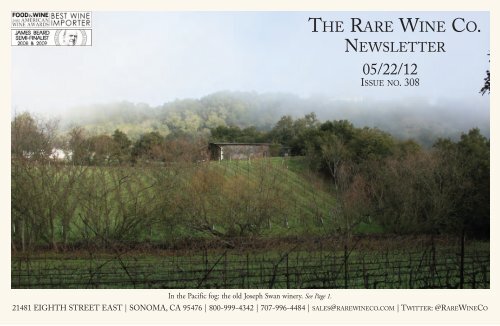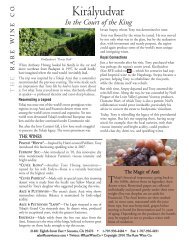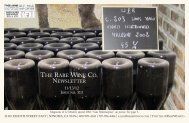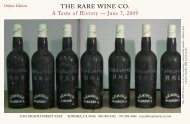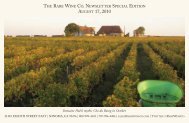Trenton Estate - Rare Wine Co.
Trenton Estate - Rare Wine Co.
Trenton Estate - Rare Wine Co.
You also want an ePaper? Increase the reach of your titles
YUMPU automatically turns print PDFs into web optimized ePapers that Google loves.
THE RARE WINE CO.<br />
NEWSLETTER<br />
05/22/12<br />
ISSUE NO. 308<br />
In the Pacific fog: the old Joseph Swan winery. See Page 1.<br />
21481 EIGHTH STREET EAST | SONOMA, CA 95476 | 800-999-4342 | 707-996-4484 | SALES@RAREWINECO.COM | TWITTER: @RAREWINECO
THE RARE WINE CO.<br />
21481 EIGHTH STREET EAST SONOMA, CA 95476 800-999-4342/707-996-4484 email us at sales@rarewineco.com<br />
M a y 2 2 , 2 0 1 2 - O N LI N E ED I T I O N<br />
For nearly 50 years, Joseph Swan has symbolized early<br />
California Pinot Noir, in the same way Heitz Cellars embodies<br />
Napa Cabernet’s early days.<br />
And so in this 308th edition of our newsletter, it is a privilege not<br />
only to tell the Swan story, but to make what could be the most<br />
remarkable offering ever of Swan’s iconic Pinot Noir, “<strong>Trenton</strong><br />
<strong>Estate</strong>.” Included are not only some very rare bottles, but also<br />
impossibly rare magnums, dating back more than three decades.<br />
You wouldn’t be reading this if not for Rod Berglund. After Joe<br />
Swan died in 1989, it was Rod who carried on his profoundly<br />
beautiful style of winemaking. Far more recently, it was Rod who<br />
dug deep into the winery’s now largely depleted library to find<br />
the bottles and magnums—in some cases the last that will ever<br />
be sold—for this offer. We are in his debt.<br />
An Historic Moment<br />
From the Library of Joseph Swan: a Three-Decade Offering of<br />
“<strong>Trenton</strong> <strong>Estate</strong>” Pinot Noir ... and the last of its kind we’ll see.<br />
¦<br />
"Reminds me quite<br />
a bit of Clos des<br />
Lambrays in its aromatic<br />
and flavor profile."<br />
John Gilman<br />
"It's hard to find words to<br />
describe its beauty."<br />
<strong>Wine</strong> Enthusiast<br />
Chardonnay.<br />
The Birth of A Movement<br />
Not many people remember Joseph Swan today, but for California Pinot Noir<br />
in the 1970s, his importance cannot be overstated.<br />
He planted his iconic <strong>Trenton</strong> <strong>Estate</strong> Vineyard in 1967, creating the first Pinot<br />
Noir vineyard to produce wine in the Russian River Valley.<br />
Then, for nearly two decades, Joe came to symbolize classic, artisanal winemaking<br />
in the same unbending way that Joe Heitz and Mayacamas’ Bob Travers did<br />
a few miles to the east. After his death, Joe’s son-in-law Rod Berglund continued<br />
his work with the same devotion to tradition.<br />
Today, looking back over the combined 45 years of Rod and<br />
Joe's work, the Swan winery looms large and heroic, to be<br />
cherished not just for its contributions to early California<br />
winemaking, but as one of the few producers that has<br />
remained true to its early ideals.<br />
A California Original<br />
Born in North Dakota, Joe Swan was a pilot who, in 1967,<br />
bought land on which to retire in the Russian River Valley.<br />
The land included some old Zinfandel vines, from which he<br />
made his first wines. Two years later, on the advice of his<br />
friend, the legendary André Tchelistcheff, he cleared and<br />
planted the property’s best site to Pinot Noir and some<br />
Today, that would seem like the obvious thing to do, but not in 1969. The<br />
Russian River Valley was rife with old zinfandel and “mixed black” vineyards,<br />
reflecting the origins of the Southern European immigrants who’d<br />
settled the area.<br />
Burgundian varietals were virtually nonexistant. And so Joe’s first vineyard was<br />
the progenitor of what has become one of the world’s great Pinot Noir regions.<br />
Joe made his first wines from his Pinot vines in 1973, and for about 15 vintages,<br />
the wines were simply labeled “<strong>Estate</strong>.” But as Rod recently recounted a
Joseph Swan <strong>Trenton</strong> <strong>Estate</strong><br />
Red Burgundy | 2<br />
a to View from the Cellar’s John Gilman, Joe was often asked<br />
by Europeans why the vineyard source of his best wines had no<br />
name. With time, the name “<strong>Trenton</strong> <strong>Estate</strong>” was chosen, honoring<br />
the community that used to be there.<br />
It’s in the Soil<br />
The land itself is a thin layer of volcanic Goldridge loam over<br />
sandstone. This soil—along with the cool morning fogs that<br />
slow and extend the grapes’ ripening—produce Pinot Noir of<br />
beautiful texture and character, with no heaviness.<br />
Rod Berglund goes even further: “It is the <strong>Trenton</strong> <strong>Estate</strong><br />
vineyard that will probably keep me making wine until the day I die: shallow<br />
soils, mostly older vines, low vigor, small crops, tiny clusters, tinier berries, cool<br />
climate, great plant material. One cannot ask for much more.”<br />
In the 1970’s, Swan’s <strong>Trenton</strong> <strong>Estate</strong> Pinot was a trophy wine for California<br />
wine collectors, and it remained so for a number of years. Soon, neighboring<br />
vineyards—<strong>Trenton</strong> Station, <strong>Trenton</strong> View—adopted the <strong>Trenton</strong> name.<br />
But as tastes changed in the 1990s, and California reds became denser and darker,<br />
Swan <strong>Trenton</strong> <strong>Estate</strong> receded into the background. Though it was made just<br />
as it was in the 1970s, and the vines were now even older, there was a smaller<br />
market for such wines from California.<br />
Less than three years before Joe Swan died in January 1989, his daughter Lynn<br />
married Rod Berglund, the talented young winemaker at La Crema—itself a terrific<br />
source of Pinot Noir<br />
and Chardonnay at that<br />
Rod<br />
Berglund<br />
in his<br />
element.<br />
Joe Swan (c) with Ravenswood’s Joel<br />
Peterson (l) and André Tchelitscheff (r)<br />
time. The next year Rod<br />
joined his father-in-law at<br />
Swan, and by the 1988 harvest,<br />
he was Swan’s winemaker,<br />
having fully<br />
absorbed Joe’s philosophy<br />
and methods.<br />
Since 1988, Rod has carried on Joe Swan’s legacy, in much the<br />
same manner as David Heitz has for his father at Heitz Cellars.<br />
The Great Swan Pinot<br />
Today, Joseph Swan produces a number of Pinot Noir cuvées.<br />
But their greatest wine—and the wine that must be on any short<br />
list of history-making California wines—is the <strong>Trenton</strong> <strong>Estate</strong>.<br />
Don’t be surprised if you’ve never been offered this wine before.<br />
Fewer than 300 cases are made in a typical year, and the winery’s<br />
mailing list absorbs almost all of it. The unique character<br />
of <strong>Trenton</strong> <strong>Estate</strong> (vis a vis the other Swan Pinots) is attributed not only to the<br />
vines' age (now over 40 years old) but also to the site's naturally tiny yields.<br />
Furthermore, this is where the "Swan clone" of Pinot Noir became famous.<br />
Looking to the future, Swan's "<strong>Trenton</strong> <strong>Estate</strong>" is poised to become a collectible<br />
as it was in the past. For the moment it is seriously undervalued, but with the<br />
pendulum swinging back to typicity, purity and unique terroirs, we know where<br />
to put our money.<br />
Rod’s Gift to All of Us<br />
Fortunately, our deep admiration encouraged Rod to give us an allocation of the<br />
newly released '09 <strong>Trenton</strong> <strong>Estate</strong>. In addition, a few months ago, we purchased<br />
the last remaining cases, perhaps in the world, of the now-rare 2007 <strong>Trenton</strong><br />
<strong>Estate</strong> that got some very big press when it was released a couple of years ago.<br />
In addition, Rod has given some of his tiny-production (101 cases) 2010<br />
Chardonnay from the Ritchie Vineyard. (The last time Rod made Chardonnay<br />
from Ritchie was in 1980!) Today, of course, Ritchie is best known for Mark<br />
Aubert’s “cult” version. Rod’s interpretation is different from Aubert’s and will<br />
appeal to those who admire his old-school approach—as well as his phenomenally<br />
low price. a
Joseph Swan <strong>Trenton</strong> <strong>Estate</strong><br />
California | 3<br />
a But here’s where this offer gets really interesting.<br />
To cap off our offer, we asked Rod if it might be possible<br />
to get some older vintages of <strong>Trenton</strong> <strong>Estate</strong> from<br />
his library, perhaps a couple from the 90s and even one<br />
or two from the 1980s. We even dared ask for a few<br />
magnums—a size we had never seen but was reputed<br />
to be made occasionally (and in tiny quantities).<br />
Rod said he would need to go through his library to see<br />
2007 Joseph Swan Pinot Noir<br />
“<strong>Trenton</strong> <strong>Estate</strong>”<br />
97 <strong>Wine</strong> Enthusiast<br />
93+ Gilman 93 Raynolds<br />
$59.95 bt. $ 145.00 mag.<br />
John Gilman: “... quite classic ... deep, full-bodied<br />
... great length and excellent intensity of flavor ...<br />
reminds me quite a bit of Clos des Lambrays in its<br />
aromatic and flavor profile ... 2013-2030+.”<br />
Josh Raynolds: “Gorgeous bouquet of red and dark<br />
berry preserves, potpourri, sandalwood and star anise.<br />
Suave and impressively silky ... lovely purity and cut<br />
... The finish clings with excellent tenacity ....”<br />
<strong>Trenton</strong> <strong>Estate</strong> Pinot Assortment #1........$545<br />
One bottle each of 1989, 1992, 1995, 1999,<br />
2004, 2006, from the winery library.<br />
<strong>Trenton</strong> <strong>Estate</strong> Pinot Assortment #2........$495<br />
One bottle each of 1991 1994, 1998, 2001,<br />
2003, 2005, from the winery library.<br />
“An absolute classic<br />
in the making”<br />
John Gilman<br />
2009 Jos. Swan Pinot Noir<br />
“<strong>Trenton</strong> <strong>Estate</strong>”<br />
93+ Gilman 93 Raynolds<br />
$54.95 bt. $ 320 6-pack<br />
Josh Raynolds: “Alluring aromas ... deep and glyceral<br />
... sweet and seamless ... superb energy and<br />
grip ... Impressively concentrated and dense, with<br />
an explosive, incisive, floral finish ....”<br />
John Gilman: “... an absolute classic in the making<br />
... the wine is deep, fullish, pure and shows<br />
off excellent intensity in the mid-palate, with<br />
superb acidity, excellent focus and balance ... outstanding<br />
length and grip on the still very primary<br />
finish ... High class and quite sophisticated pinot.<br />
2015-2045+.”<br />
Jewels from the Library<br />
<strong>Trenton</strong> <strong>Estate</strong> Pinot Assortment #3........$399<br />
One bottle each of 1999, 2000, 2001, 2003,<br />
2004, 2005, from the winery library.<br />
<strong>Rare</strong>st Magnums from the Library<br />
1982 <strong>Trenton</strong> <strong>Estate</strong> Pinot Magnum ............225.00<br />
1983 <strong>Trenton</strong> <strong>Estate</strong> Pinot Magnum ............225.00<br />
what was left. (He is famous for his generosity, and there’s<br />
very little remaining from the past). And so we waited,<br />
fingers crossed, to see what he could offer us.<br />
Though most quantities were limited to the few bottles<br />
he had left, Rod gave us 18 different vintages from<br />
1982 to 2006. And as noted above, in a number of<br />
cases, these will be the last bottles (or magnums) from<br />
the library that will ever see the light of day.<br />
2010 Joseph Swan<br />
Chardonnay<br />
“Ritchie Vineyard”<br />
$38.95 bt. $ 220 6-pack<br />
Just 101 cases made. The exceptionally cool 2010<br />
growing season produced a wine with striking minerality,<br />
refined fruit, very good acidity, yet with the<br />
size you expect from this vineyard. Clean, zesty and<br />
citrusy nose with subtle notes of vanilla and Asian<br />
pear and green apple. Entry is full but well-focused<br />
and Burgundian in mouthfeel, thanks to the wine’s<br />
acidity. Fine concentration and underlying minerality.<br />
A very complete wine that should age gracefully.<br />
1984 <strong>Trenton</strong> <strong>Estate</strong> Pinot Magnum ............325.00<br />
1985 <strong>Trenton</strong> <strong>Estate</strong> Pinot Magnum ............245.00<br />
2006 <strong>Trenton</strong> <strong>Estate</strong> Pinot Magnum ............145.00<br />
And a couple of extra cherries ...<br />
1984 <strong>Trenton</strong> <strong>Estate</strong> Pinot 750ml................150.00<br />
1990 <strong>Trenton</strong> <strong>Estate</strong> Pinot 750ml................145.00
The release of Henri Bonneau’s 2005 Reserve des Celestins is<br />
potentially the biggest story in Châteauneuf du Pape this year.<br />
A wine of epic dimension, it takes its place with the four greatest<br />
Célestins of the past quarter century: '89, '90, '98 and '01.<br />
And if the price trajectory of its predecessors is any guide, it’s a<br />
wine you’ll want to buy now.<br />
It’s Here.<br />
A New Bonneau Célestins to Rival the 1989, '90, '98 & '01<br />
One of a Kind<br />
<strong>Wine</strong>s often reflect the personalities of their makers, and for no<br />
one is this more true than Henri Bonneau. One of the most Henri Bonneau<br />
engaging winemakers we’ve ever met, Bonneau is a larger-than-life<br />
figure who has inspired every Châteauneuf winemaker born in the past half century.<br />
He is famous for waiting six to eight years to release his greatest wines. And so,<br />
despite the fact that his neighbors are now offering their 2010s, the seven-year wait<br />
for the 2005 is “normal” for a great vintage of Célestins. It took him that long to<br />
select the barrels—and then to decide that the wine was ready to meet the world.<br />
For decades, Bonneau has been considered the heart and soul of the Southern<br />
Rhône. But on the death of Rayas’ Jacques Reynaud in 1997, he acquired a second<br />
mantle: that of the region’s greatest winemaker.<br />
Clerico’s 2007 Barolo Ciabot Mentin<br />
"98 rating ... one of the greatest wines I have<br />
ever tasted at this address." Antonio Galloni<br />
Aleader of Piedmont's modernist movement in the 1980s, Domenico<br />
Clerico has never stopped searching for the best way to express his vineyards.<br />
His 2007 Barolo Ciabot Mentin, released last year, could be the<br />
finest wine he’s ever made.<br />
“The<br />
appellation’s<br />
most ferocious<br />
guardian of<br />
traditionally<br />
made<br />
Châteauneuf”<br />
R. Parker<br />
The Glorious 2005<br />
For twenty years, this newsletter has been America’s pipeline to<br />
Bonneau. In our very first issue in September 1992, we offered<br />
1989 Célestins for $42.95. Fortunately, our relationship with<br />
the domaine is as warm as ever, and we can once again offer an<br />
historic vintage of Célestins at a price which is very possibly<br />
the lowest in America.<br />
2005 Henri Bonneau CDP Réserve des Célestins*<br />
97+ Parker<br />
$245.00 bt. $ 1435 six pack<br />
Parker: “The vintage about which Bonneau is most excited ... obviously built for<br />
30-40 years of longevity ... great fruit and huge notes of lavender, soy, hoisin<br />
sauce, smoked duck, beef blood, black currants, plums and figs. This massive,<br />
concentrated wine finishes with excruciatingly high tannins and lots of structure<br />
...This amazing Châteauneuf du Pape may turn out to be one of the two or three<br />
finest wines of the vintage ....”<br />
2007 Clerico Barolo Ciabot Mentin<br />
$96.95<br />
Galloni: “98 rating ... profound, breathtaking personality.<br />
The 2007 shows tons of Ginestra nuance,<br />
but with extra dimensions to the fruit that literally covers every nook and<br />
cranny of the palate.”
Spain’s Other Glories<br />
López de Heredia’s Magnificent, <strong>Rare</strong> Viña Tondonia White Gran Reservas<br />
Rioja | 5<br />
No school of winemaking produces such unique character<br />
and complexity as Rioja’s traditionalists. And while their<br />
way of doing things is fast disappearing, a handful of old<br />
firms have stuck to their guns, fashioning wines of startling elegance<br />
and nuance. The standard-bearer is certainly López de Heredia.<br />
López de Heredia is best known for its nearly immortal red Gran<br />
Reservas. But the top whites are just as magical and long-lived.<br />
One particularly brilliant example is their current release, the 1991<br />
Viña Tondonia Blanco Gran Reserva. Another is the iconic 1981,<br />
of which just a small amount remains in the bodega’s library.<br />
One of Rioja’s Greatest Terroirs<br />
These Gran Reservas are sourced from ancient Viura vines, complemented<br />
by a small amount of Malvasia, in López de Heredia’s iconic<br />
Tondonia vineyard, widely regarded as one of Rioja’s greatest white terroirs.<br />
The López de Heredia family considers 1991 to be one of Viña Tondonia’s all-time<br />
“Perhaps no winery in the<br />
world guards its traditions<br />
as proudly and steadfastly as<br />
López de Heredia does.”<br />
Eric Asimov, NY Times<br />
“Viña Tondonia Blanco is<br />
absolutely one of my favorite<br />
dry white wines produced<br />
anywhere in the world.”<br />
John Gilman<br />
finest vintages; consequently they aged the Blanco Gran Reserva<br />
for an astonishing ten years in immaculate old barrels to maximize<br />
its opulent, honeyed character and kaleidoscopic complexity.<br />
As a vintage, 1981 may be even more famous, particularly for Viña<br />
Tondonia Blanco. First released as a Gran Reserva eight years ago,<br />
today López has little left. We were indeed fortunate to get some.<br />
Preferred Access<br />
As always, it’s a great privilege to have access not only to López’s<br />
current releases, but to the rarest bottles from the family<br />
library—each bottle shipped directly to us in our own temperature-controlled<br />
container.<br />
And so the magnificent '81 and '91 whites are now resting comfortably<br />
with us. Both are, of course, fully mature, but each promises<br />
decades more of further aging. These are must purchases for those who love traditional<br />
Rioja—as well as great white wine generally.<br />
1991 López de Heredia<br />
Viña Tondonia Blanco Gran Reserva<br />
94 Josh Raynolds<br />
$79.95 bt. $ 470 6-pack<br />
Josh Raynolds: “... Explosively perfumed nose offers an array of citrus and orchard<br />
fruits, with exotic nuances of mace, chamomile and honey. Rich and deeply pitched<br />
but almost shockingly vibrant, offering spicy pear, nectarine and lemon pith flavors.<br />
Suavely blends richness and vivacity, finishing with excellent clarity and length.<br />
This should age at a snail’s pace.”<br />
1981 López de Heredia<br />
Viña Tondonia Blanco Gran Reserva<br />
94+ John Gilman<br />
$129.95 bt. $ 750 6-pack<br />
John Gilman (2009): “… drinking brilliantly at age twenty-seven ... truly magical<br />
... superb mélange of orange zest, lemon, sea salts, fresh almonds, a hint of green<br />
olive, grapefruit and white soil tones. On the palate the wine is full-bodied, deep<br />
and racy, with great precision and focus, bright acids, a rock solid core and a very<br />
long, classy and bouncy finish ... I would not hesitate to keep this tucked away in<br />
the cellar for a few more years before drinking it with really wild abandon ... the<br />
next legendary bottle of this wine after the surreal 1964 and 1957.”
Pages from Barolo’s History<br />
Marchesi di Barolo’s 1970 and 1971 Barolos<br />
The origin of Barolo as we know it today can be<br />
traced back to the historic house of Marchesi di<br />
Barolo. In the first half of the nineteenth century,<br />
they were the first to produce Nebbiolo as a rich, dry wine<br />
and the first to label it as Barolo.<br />
These revolutionary developments were based on the quality<br />
of the fruit from their wealth of vineyards spread over La<br />
Morra, Barolo and Serralunga d’Alba, but particularly from<br />
the region’s greatest cru, Cannubi.<br />
1971 Marchesi di Barolo’s cellars, and what remained of their glorious<br />
holdings, were acquired by the Abbona family in 1929<br />
and they continued the firm’s tradition of blending great<br />
Barolos from their crus, with Cannubi at its core, until 1975.<br />
That was the year they first bottled Cannubi separately, having<br />
decided that the wine from this iconic vineyard merited<br />
its own bottling. And while this means that the classic Barolo<br />
in subsequent vintages was now lacking its heart, the years<br />
prior to 1975 were enriched by Cannubi’s velvety texture and<br />
aromatic complexity.<br />
<strong>Co</strong>nsequently, we were delighted recently to acquire, in Italy,<br />
a few well-cellared cases of the 1970 and 1971 vintages. As you would expect<br />
from such a historic house, the wines were made by thoroughly traditional<br />
methods and have stood the test of time beautifully.<br />
Here’s a rare opportuntiy to experience two classic examples of Barolo’s old<br />
school at very attractive prices. Quantities are limited.<br />
1971 Marchesi di Barolo Barolo* ...............................................135.00<br />
1970 Marchesi di Barolo Barolo* ...............................................110.00<br />
Piedmont & Muscadet | 6<br />
We Got More!<br />
Chasseloir’s 2007 “Cuvée Ceps Centenaires”<br />
from the Oldest Muscadet Vines in Existence<br />
One of last year’s most compelling offers was the 2007 Ch. de Chasseloir<br />
Muscadet Cuvée Ceps Centenaires.<br />
Made from the oldest Muscadet vines in existence, this wine is aged sur lie and<br />
conveys the mineral essence of an exceptional volcanic terroir. The Chasseloir<br />
Ceps Centenaires also has a history of developing for decades, becoming increasingly<br />
complex and creamy textured.<br />
And at $18.95, it’s one of the planet’s greatest wine bargains.<br />
This modestly priced wine is made by the Chéreau-Carré family, which has been<br />
in Muscadet since 1412. Since 1953, they have owned the Ch. de Chasseloir.<br />
The Ceps Centenaires is their top cuvée and a wine that began as a private cuvée<br />
made just for the family.<br />
When we first offered the 2007 Cuvée Ceps Centenaires last August, we went<br />
through a boatload of it. However, we were able to get the last cases in the market.<br />
You will not want to miss this.<br />
2007 Ch. de Chasseloir<br />
Muscadet “Cuvée Ceps Centenaire”<br />
92 <strong>Wine</strong> Advocate<br />
$18.95<br />
David Schildknecht: “... a sensational value. Scents of sea breeze; honeydew and<br />
musk melon; and fresh lemon lead into an expansive yet persistently refreshing<br />
palate, featuring rich hints of nut oils beneath bright, juicy, brine-crusted waves of<br />
melon and citrus ... strikingly tactile in its sense of minerality. Close your eyes and<br />
just try making yourself believe that salt water and chalk have not somehow been<br />
transported into this wine ... worth following for at least the next ten years.”
Larmat’s Map of<br />
Beaujolais, 1942.<br />
A <strong>Rare</strong> Beaujolais Opportunity<br />
Pristine 2005s from Two Legendary Domaines<br />
The wine world is full of injustices: producers who<br />
get far less attention than they deserve.<br />
Until the 2009 vintage, Beaujolais had more than its<br />
share of these overlooked heros. But in that watershed<br />
year, the world discovered such hidden giants as Marcel<br />
Lapierre, Foillard and Clos de la Roilette.<br />
Of course, these and other top domaines had been<br />
making great wine for years—if not for decades. A case<br />
in point was the Geoffrays of Ch. Thivin, who had single-handedly<br />
made the Côte de Brouilly an elite address<br />
for vin de garde Beaujolais.<br />
Remarkable Longevity<br />
John Gilman—who knew the skinny in Beaujolais long<br />
before most other critics—has described the Geoffrays'<br />
Ch. Thivin as “one of the most important historic<br />
domaines in all of Beaujolais, and the Geoffrays make<br />
very traditionally structured and deep wines that are slow to unfold, but which offer<br />
up superb longevity that can only be matched by the very top domaines in Morgon<br />
Beaujolais | 7<br />
and Moulin-à-Vent ... All that is needed here is a little patience to discover one of the<br />
very top wines in the region."<br />
Another example is Bernard Diochon who, in Gilman's words, has "for many<br />
years been one of the flagship producers of Moulin-à-Vent ... (their) wines age<br />
magnificently and are clearly amongst the very finest to be found in the region<br />
... the Diochon wines are textbook examples of Moulin-à-Vent ...."<br />
This Extraordinary Offer<br />
If you bought the Ch. Thivin and Diochon 2009s, you made a wise investment.<br />
But there’s nothing like drinking these wines with a few years of bottle age.<br />
Fortunately, a friend in Europe has been buying and cellaring Ch. Thivin and<br />
Diochon for years and let us have some of his most prized wines from the great<br />
2005 vintage. Included was the rare and extraordinary "La Chapelle" bottling.<br />
These wines are now unavailable anywhere in the U.S. And the provenance is<br />
exemplary.<br />
Don't miss this important opportunity to lay in two certified Beaujolais legends with<br />
a few prized years under their belts ... yet with two decades of further aging potential.<br />
2005 Ch. Thivin Côte de Brouilly<br />
Cuvée La Chapelle*<br />
$28.95 bt. $ 165 six-pack<br />
John Gilman: "93 rating. In 2005 Monsieur Geoffray bottled a bit of the La<br />
Chapelle on its own ... more fruit-driven ... it jumps from the glass in a blaze of<br />
plums, black cherries, cocoa, a touch of game and a nice base of soil ... On the<br />
palate the wine is deep, full and quite powerfully built, with broad shoulders, an<br />
intense, sappy core of fruit, ripe tannins, and a long, powerful and primary finish ...<br />
will be a stellar example of the vintage ... superb. (Drink between 2010-2030)"<br />
2005 Dom. Diochon<br />
Moulin-à-Vent*<br />
$34.95 bottle<br />
John Gilman: "95 rating ... brilliance of Beaujolais with the stunning 2005 Moulin-à-<br />
Vent from Domaine Diochon. The bouquet is deep, primary and stunning, as it soars<br />
from the glass in a mélange of black cherries, dark berries, vinesmoke, herbs, earth, a<br />
touch of espresso and a topnote of peppercorn. On the palate the wine is full-bodied,<br />
pure and sappy on the attack, with a great core of fruit, laser-like focus, and great tanginess<br />
and grip on the stunning backend. Glorious juice. (Drink between 2010-2030)"
Perrone’s 2011 Moscato Clarté<br />
“Literally redefines what is possible with the grape.”<br />
Antonio Galloni on Stefano Perrone’s Clarté<br />
Piedmont | 8<br />
November 1995. We were in Piedmont, as the autumn’s Moscatos<br />
were hitting store shelves, just in time for Christmas.<br />
In search of the region’s greatest Moscato for our import portfolio, we<br />
seized the opportunity to taste the newly bottled 1995 Moscatos<br />
from nearly two dozen of the most highly regarded local producers.<br />
Two stood out: Saracco, which at that time was considered the best<br />
by insiders. The other was made by an unknown former motocross<br />
racer, Stefano Perrone. As phenomenal as the Saracco was, we gave a slight<br />
edge to Perrone’s wine. And so our deep friendship with Stefano (and later his<br />
wife Giuliana) began.<br />
The New Order<br />
Fast forward 17 years. Today, Stefano’s wine is considered by many the<br />
world’s greatest example of Moscato. He is the superstar—the guy who can<br />
wring every last drop of nuance out of the Moscato grape, and can do so with<br />
surreal balance of sugar and acidity.<br />
We’ve also learned over the past 17 years that the Moscatos released for<br />
Christmas may not even be the producers’ best. Perrone is a case in point: he<br />
holds back the best part of each harvest to produce Clarté, for release the next<br />
spring. If any wine expresses the essence of the Moscato grape, it is Clarté.<br />
For the<br />
First Time<br />
in 6 Years:<br />
Magnums!<br />
Galloni’s Take<br />
In writing about the 2010 vintage, Antonio Galloni nailed it, by<br />
calling Clarté one of “Italy’s great dessert wines. Low yields and a<br />
superb site result in one of the most intense Moscati readers are<br />
likely to come across. It is not an understatement to say this is a<br />
wine that literally redefines what is possible with the grape.”<br />
Galloni continues: “Exotic flowers, lime, green pears and the essence<br />
of crushed rocks flow effortlessly from this dazzling wine. The Clarté has the<br />
focus and cool, piercing minerality of a great Chablis, but of course with the<br />
sweetness of Moscato.”<br />
The 2011 Clarté has just been bottled and it’s on its way to us (as always, in a<br />
temperature-controlled container set to 55 degrees). Just 400 cases were made.<br />
But before it left Stefano’s cellar, we repeated our November, 1995, tasting. Lining<br />
up two dozen different 2011 Moscatos in a Castiglione Tinella trattoria, none of<br />
the competitors even came close to matching the precision of 2011 Clarté.<br />
2011 Elio Perrone<br />
Moscato “Clarté”<br />
$18.95 bottle $39.95 magnum<br />
THE RARE WINE CO.<br />
21481 EIGHTH STREET EAST SONOMA, CA 95476 800-999-4342/707-996-4484 email us at sales@rarewineco.com<br />
M a y 2 2 , 2 0 1 2 - O N LI N E ED I T I O N<br />
<strong>Wine</strong>s may be sold and delivered only to persons who are at least 21 years old. All wines are sold in California and title passes to the buyer in California. We make no representation to the legal rights of anyone to ship or import wines into any state outside of<br />
California. We are not responsible for typographical errors. All items and prices subject to availability. Request a copy of our terms of sale or read them at www.rarewineco.com. Issued 14 times yearly. © 2012 The <strong>Rare</strong> <strong>Wine</strong> <strong>Co</strong>.


